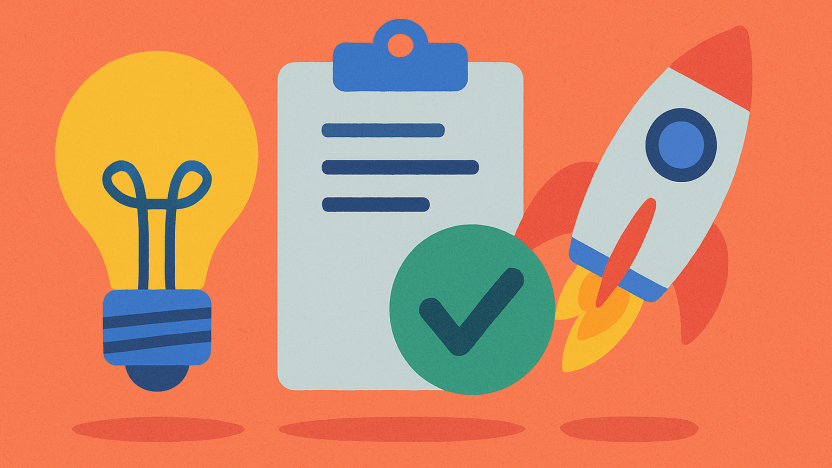The Lean Startup Approach: How to Validate Your Idea and Avoid Failure is a methodology that has revolutionized the way entrepreneurs approach building new businesses. Developed by Eric Ries, this method emphasizes scientific experimentation and validated learning, ensuring that startups efficiently discover what their customers truly want.
Key principles of the Lean Startup Approach include:
- Build-Measure-Learn Feedback Loop: A cycle where startups create a Minimum Viable Product (MVP), measure its performance, and learn from the results.
- Validated Learning: Focusing on real customer feedback rather than assumptions.
- Continuous Iteration: Adapting products quickly based on market needs.
By adopting the Lean Startup approach, entrepreneurs can significantly increase their chances of success. Validating ideas early helps in minimizing risks and avoiding failure. This methodology is highly relevant in today’s fast-paced startup ecosystem where rapid innovation and adaptability are crucial for survival and growth.
Understanding the Lean Startup Methodology
What is the Lean Startup Approach?
The Lean Startup approach is a method designed to help startups succeed by focusing on:
- Experimentation
- Customer feedback
- Iterative design
It aims to create a sustainable business model through continuous innovation and learning based on real-world data.
Key Principles:
- Build-Measure-Learn Feedback Loop: Startups develop a Minimum Viable Product (MVP), measure its performance using real customer feedback, and learn from the results to iterate or pivot.
- Validated Learning: Prioritizing knowledge gained from customer interactions over assumptions.
- Hypothesis Testing: Structuring tests around value hypotheses (will customers pay for this solution?) and growth hypotheses (how do we reach more customers?).
- Continuous Iteration: Rapidly updating products based on feedback to better meet market needs.
- Innovation Accounting: Using metrics that track learning and progress in developing a sustainable business model.

How Did Eric Ries Develop It?
Eric Ries developed the Lean Startup methodology based on his own experiences as a startup founder. His journey began with several failed startups, where he learned that traditional business plans often fall short in dynamic markets.
He drew inspiration from Toyota’s lean manufacturing principles, which focus on minimizing waste while maximizing productivity.
By applying these principles to startups, Ries created a framework that helps entrepreneurs navigate uncertainty. His book, The Lean Startup, published in 2011, has since become a guiding text for new ventures seeking efficient paths to market success.
How Does It Relate to Agile Principles?
The Lean Startup approach shares many similarities with Agile principles, which are widely used in software development:
- Customer Collaboration: Both methodologies emphasize working closely with customers to understand their needs.
- Iterative Development: Agile promotes short development cycles with frequent releases, aligning perfectly with the Lean Startup’s Build-Measure-Learn loop.
- Flexibility: Adaptability and responsiveness are central tenets of both approaches, allowing teams to adjust quickly based on feedback.
These connections highlight why the Lean Startup methodology is particularly relevant for tech-driven startups. However, it’s crucial to note that while the term “Lean Startup” is widely used, it is often misapplied or misunderstood. As pointed out in a Medium article, the essence of this methodology should not be lost in buzzword misuse. By integrating Agile practices, startups can enhance their ability to innovate swiftly and effectively.
The Power of Validated Learning in Product Development
Build-Measure-Learn Feedback Loop
The Build-Measure-Learn feedback loop is the backbone of the Lean Startup methodology. This iterative process involves creating a product (Build), measuring its performance in the market (Measure), and learning from the results (Learn).
- Build: Start with a Minimum Viable Product (MVP) that has just enough features to test your core hypothesis.
- Measure: Collect data on how customers interact with your MVP. This can be through analytics, surveys, or direct feedback.
- Learn: Analyze the data to determine whether your hypothesis is correct. Use these insights to make informed decisions about the next steps—whether to persevere, pivot, or iterate.
Importance of Validated Learning
Validated learning transforms assumptions into knowledge through real-world experimentation. Instead of relying on guesswork, startups gather empirical evidence that guides their development strategies.
- Customer-Centric Development: By continuously validating ideas with actual users, startups ensure they are solving real problems and meeting genuine needs.
- Resource Efficiency: Avoid wasting time and money on features or products that don’t resonate with customers.
- Informed Decision-Making: Data-driven insights help entrepreneurs make strategic decisions, reducing uncertainty and risk.
A prime example is Dropbox. They initially validated their idea by creating a simple video demonstrating their product concept. This low-cost experiment gathered significant interest and feedback, guiding them as they developed their MVP.
By focusing on validated learning through the Build-Measure-Learn feedback loop, startups can navigate the uncertainties of product development more effectively, increasing their chances of success.
Using Minimum Viable Products (MVPs) for Market Testing
Minimum Viable Product (MVP) is a concept central to the Lean Startup approach. An MVP represents the simplest version of a product that can be released to early customers. The primary purpose of an MVP is to gather validated learning about customers with the least amount of effort.

What is an MVP?
An MVP is an initial version of a product that includes only the core features necessary to deliver value to early adopters.
Why Use an MVP?
The main goal is to test assumptions and gather feedback from real users, enabling startups to validate their business ideas quickly and cost-effectively. By focusing on essential features, startups can avoid wasting resources on unnecessary functionalities.
How MVPs Help Startups
MVPs play a crucial role in helping startups during the early stages of product development:
- Quick Feedback Loop: By launching an MVP, startups can quickly enter the Build-Measure-Learn feedback loop. This allows them to assess how well their product meets customer needs and identify areas for improvement.
- Market Testing: Early stage products can be tested in real market conditions, providing insights into customer behaviors, preferences, and pain points. This real-world data is invaluable for making informed decisions about future product iterations.
- Resource Efficiency: Developing an MVP minimizes financial risks by ensuring that significant investments are only made once key assumptions have been validated.
Real-World Example
Dropbox began as a simple video demonstration showing its proposed functionality before developing a full-fledged product. This allowed them to gauge interest and collect valuable feedback without heavy upfront investment.
By leveraging MVPs, startups can experiment rapidly, engage with their target audience early, and refine their offerings based on actual user input. This iterative process increases the likelihood of creating a product that resonates with customers and achieves market success.
Developing Your MVP Effectively: Best Practices and Common Pitfalls to Avoid
Creating an MVP that truly resonates with your target audience involves a series of deliberate steps to ensure alignment with user needs. Here’s how you can develop an effective MVP:
Steps to Develop an Effective MVP
1. Identify Core Features
- Focus on the essential features that solve your target customers’ primary problem.
- Avoid adding unnecessary functionalities that do not directly address user needs.
2. Define Success Metrics
- Establish clear success criteria for what you want to achieve with your MVP.
- This could be metrics like user engagement, conversion rates, or customer feedback.
3. Build a Prototype
- Develop a simple, functional version of your product that showcases the core features.
- Ensure it is enough to demonstrate value but not overly complex.
4. Gather Initial Feedback
- Release the MVP to a small group of early adopters or beta testers.
- Collect their feedback on usability, functionality, and overall satisfaction.
Techniques for Validating User Needs
Accurate validation of user needs is crucial for refining your product. Here are some techniques:
- Conduct Surveys:
- Create surveys to gain insights into customer preferences and pain points.
- Use tools like Google Forms or SurveyMonkey for easy distribution and analysis.
- Run A/B Tests:
- Implement A/B testing to compare different versions of your MVP.
- Analyze which version performs better in terms of user engagement or other key metrics.
- Usability Testing:
- Observe real users as they interact with your MVP.
- Identify any usability issues and gather qualitative data on their experience.
- Customer Interviews:
- Conduct one-on-one interviews to dive deeper into individual experiences and expectations.
- Use these insights to make informed product adjustments.
Common Pitfalls to Avoid
- Overcomplicating the MVP: Avoid adding too many features that can dilute the core value proposition.
- Ignoring Customer Feedback: Paying no heed to user feedback can lead to building a product that doesn’t meet market needs.
- Premature Scaling: Scaling up without validating key assumptions can result in wasted resources and potential failure.
By carefully following these steps and techniques, you can effectively develop an MVP that meets user needs while avoiding common pitfalls, setting a solid foundation for further iterations and development.
Hypothesis Testing: A Crucial Component of the Lean Startup Approach
Hypothesis testing is a cornerstone of the Lean Startup methodology. It enables startups to make informed decisions throughout the product development process rather than relying on guesswork or assumptions.
Importance of Hypothesis Testing
- Informed Decision-Making: By testing hypotheses, startups can validate whether their ideas align with market demands and customer needs. This reduces the risk of investing time and resources into unproven concepts.
- Data-Driven Approach: Hypothesis testing provides concrete data, allowing startups to pivot or persevere based on real-world feedback, ensuring that decisions are grounded in reality rather than intuition.

Differentiating Between Value Hypotheses and Growth Hypotheses
Understanding the types of hypotheses is crucial for effective hypothesis testing:
1. Value Hypotheses
These focus on whether a product or feature solves a customer problem.
- Example: A startup might hypothesize that users will pay for a premium feature that saves them time.
- Test: Launching an MVP with this feature and tracking user engagement and willingness to pay can validate this hypothesis.
2. Growth Hypotheses
These aim to identify how a startup can acquire and retain users effectively.
- Example: A hypothesis could be that offering a referral bonus will drive new user sign-ups.
- Test: Implementing a referral program in an MVP and measuring the increase in user registrations can confirm or refute this hypothesis.
By separating these hypotheses, startups can systematically address both customer value and growth strategies, enhancing their overall business model.
Incorporating hypothesis testing into your Lean Startup approach ensures that every step you take is backed by empirical evidence, paving the way for sustainable growth and innovation.
Continuous Iteration Based on Customer Feedback: Fueling Innovation in Startups
Continuous iteration is a key part of The Lean Startup Approach, crucial for adapting products to meet changing market demands and customer expectations. This practice involves making small improvements based on real-time feedback, ensuring that the product stays relevant and valuable.
Why Continuous Iteration Matters
- Adaptability: By continuously iterating, startups can quickly respond to changes in the market or shifts in customer needs, maintaining a competitive edge.
- Risk Mitigation: Small, frequent updates reduce the risk associated with major overhauls. If an iteration fails, it’s easier to pivot without significant loss.
- Customer-Centric Development: Regular updates keep the product aligned with what customers actually want, increasing satisfaction and loyalty.
How to Gather Actionable Customer Feedback
To fuel continuous iteration, startups need effective methods to gather and analyze customer feedback. Here are some strategies:
- Online Reviews: Monitor platforms where customers leave reviews. Pay attention to recurring themes or issues.
- Usability Tests: Conduct tests where users interact with your product while providing real-time feedback. This helps identify pain points and areas for improvement.
- Surveys and Polls: Use targeted surveys to gather specific insights about user experience and preferences.
- Social Media Listening: Track mentions and discussions about your product on social media channels to understand public perception and potential areas for enhancement.
- Direct Customer Interviews: Engage directly with users through interviews to dive deep into their experiences and expectations.
“Continuous iteration based on customer feedback is not just about fixing problems; it’s about evolving your product in sync with your users’ needs.”
Using these strategies ensures that each iteration brings meaningful improvements, keeping the product in line with market demands and enhancing overall user satisfaction.
Embracing Innovation Accounting as a Startup Metric System
Innovation accounting is a crucial concept for startups, particularly those navigating uncertain markets. Traditional financial metrics often fall short in capturing the progress and learning essential for early-stage ventures. Innovation accounting bridges this gap by focusing on actionable data that reflects real-time feedback and iterative improvements.

What is Innovation Accounting?
Innovation accounting involves tracking metrics that provide insights into how effectively a startup is learning and evolving its product. This method helps entrepreneurs:
- Measure progress through validated learning.
- Make informed decisions based on empirical data.
- Adapt strategies quickly to meet market demands.
Why It’s Essential for Startups
Startups operate under conditions of extreme uncertainty. With limited resources, making every decision count becomes vital. Innovation accounting offers a structured approach to:
- Identify what works and what doesn’t at an early stage.
- Avoid costly mistakes by pivoting based on real-world feedback.
- Optimize resource allocation by focusing on high-impact activities.
Key Metrics Beyond Traditional Financial Indicators
To truly benefit from innovation accounting, startups must look beyond typical financial indicators like revenue or profitability. Here are some critical metrics to consider:
- Customer Acquisition Cost (CAC): The cost associated with acquiring a new customer.
- Lifetime Value (LTV): The projected revenue from a customer over their lifetime.
- Retention Rate: The percentage of customers who continue to use the product over time.
- Churn Rate: The percentage of customers who stop using the product within a given period.
- Activation Rate: The proportion of users who take a key action that signifies their engagement with the product.
By focusing on these metrics, startups can gain valuable insights into user behavior, market fit, and overall business viability. This actionable data enables continuous improvement and paves the way for sustainable growth.
Case Studies: Real-World Applications of the Lean Startup Approach
Spotify Case Study
Spotify, a leading music streaming service, has effectively used the Lean Startup methodology to innovate and grow quickly. By embracing continuous iteration and the Build-Measure-Learn feedback loop, Spotify managed to improve its product and meet user expectations.
Key strategies:
- MVP Development: Spotify initially launched with a limited feature set to test user interest. This allowed them to gather valuable feedback without significant upfront investment.
- Validated Learning: They continuously collected data on user behavior and preferences, enabling them to make informed decisions about product features.
- Hypothesis Testing: Spotify tested various hypotheses on music discovery and social sharing, leading to popular features like personalized playlists.
Microsoft Office Case Study
A contrasting example comes from Microsoft Office’s Clippy, a virtual assistant intended to help users navigate the software. Despite significant resources invested, Clippy is often cited as a failure due to its poor reception.
Lessons learned:
- Lack of User Feedback: Clippy was developed with minimal input from actual users, leading to widespread frustration and rejection.
- Failure in Iteration: Instead of iterating based on user feedback, Microsoft continued with Clippy’s original design, which did not align with user needs.
Thomas Edison Case Study
Thomas Edison’s approach exemplifies the principles behind the Lean Startup methodology long before it was formally articulated. His development of the electric light bulb involved extensive experimentation and iterative testing.
Edison’s techniques:
- Continuous Iteration: Edison tested thousands of materials for the filament before finding a viable solution.
- Validated Learning: He focused on learning from each failed attempt, understanding what worked and what didn’t.
These case studies highlight how adopting or neglecting Lean Startup principles can significantly impact a company’s success. Using validated learning and continuous iteration can drive innovation, while ignoring user feedback risks failure.
FAQs (Frequently Asked Questions)
What is the Lean Startup Approach?
The Lean Startup Approach is a methodology developed by Eric Ries that focuses on validating business ideas early in the startup process to minimize risks and increase the chances of success. It emphasizes rapid experimentation, validated learning, and iterative product development.
How does the Build-Measure-Learn feedback loop work?
The Build-Measure-Learn feedback loop is a core concept in the Lean Startup methodology. It involves building a Minimum Viable Product (MVP), measuring its performance through customer feedback, and learning from the results to make informed decisions about product development.
What is a Minimum Viable Product (MVP)?
A Minimum Viable Product (MVP) is an early-stage product that includes only the essential features necessary to gather customer feedback and validate business ideas. MVPs facilitate rapid market testing and allow startups to experiment without significant investment.
Why is hypothesis testing important in the Lean Startup Approach?
Hypothesis testing is crucial in the Lean Startup Approach as it enables entrepreneurs to make informed decisions based on data rather than assumptions. It helps differentiate between value hypotheses, which focus on solving customer problems, and growth hypotheses, which aim at user acquisition.
What role does continuous iteration play in product development?
Continuous iteration is vital for adapting products to changing market demands. By regularly gathering actionable customer feedback through methods like usability tests or online reviews, startups can refine their offerings and innovate effectively.
What is innovation accounting and why is it important?
Innovation accounting refers to a system of metrics designed for startups operating under uncertainty. It focuses on measuring progress through actionable data rather than traditional financial indicators, helping entrepreneurs assess their growth and make strategic decisions.



